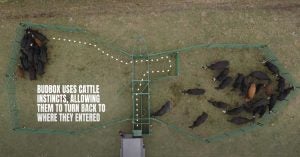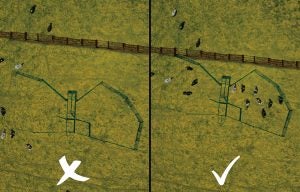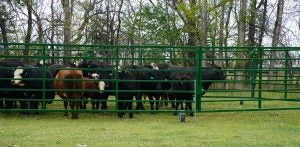When it comes to the time of year when cattle need to either head out to pasture or be brought closer to home, it can be an event you either look forward to or dread, depending on the cattle equipment you have available and how you use it. Portable corrals can significantly improve how you are able to work your cattle, no matter where they are.
The flexibility that portable cattle corrals provide, combined with their adaptability, make them easy to transport and come in handy for operations with cattle in multiple locations away from the ranch and main cattle handling system. When it comes to using a portable corral, there are several key things to keep in mind to ensure you set yourself and your cattle up for a stress-free working experience.
Layout and features matter
Most portable corrals have several features that make setup, tear down, and working cattle simple. Some key features to look for include:
- Center alleyway with pens formed with fold-out panels
- Airless tires on a winch system on panels that assist with set up and tear down
- Hydraulic jacks on the main frame
- Included bud box or smaller sorting pens
- Head gate or ability to connect a chute
- A cargo area for your quad or storage
- Tow hitch to haul your chute, ATVs, etc.
Other than a straightforward setup, ensure you’re able to move throughout the corral safely and easily. Well-placed gates in the pens and designated cattle-free working areas that allow you to work cattle using their flight zones are features that will enhance your overall working experience.
It is also important that a portable corral is designed with animal science in mind and works with cattle’s natural instincts. This will create a low stress working environment, give you better cattle flow, and make getting the job done easier, faster, and safer.

Ensure your portable cattle corral doesn’t just include all the bells and whistles, it needs to have the features that you need and will use. Having the ability to carry additional corral panels and gates can come in handy for bringing up your cattle and for creating additional holding pens or a bud box to assist with sorting.
Use location to your advantage
Before you set up your portable corral and get to work, it’s important to evaluate your site. Where you choose to set up your corral sets the foundation of how you’ll work your cattle, and there are several factors to consider.
- Can a truck and trailer easily get to the location and turn around?
- Will cattle have to ride in the trailer across rough terrain for a long time?
- Are there drainage ditches or deep ruts you can get hung up on?
- Are there natural water sources or existing structures to be aware of?
Plan how far you will need to move cattle to bring them up to the corral, and if this distance is realistic for the time you have. Also consider how you’ll be moving cattle, whether it’s on foot, by horse, or with ATVs. Always aim to keep cattle stress levels low.

Consider setting up your portable corral along a fence line to use it as a natural lead up, guiding cattle along the fence and eventually into the corral pen. Aim to avoid thick bush, natural water sources and any other obstacles when bringing up cattle to ensure the herd is kept together to help keep stress levels low and make moving the herd to the portable corral as easy as possible.
Less is sometimes more
When using a portable corral, one question that will inevitably cross your mind is how many cattle can be worked in it at once? This number varies depending on the portable corral you have, but there is a simple equation you can use to be sure your corral will meet your needs.
Start with your herd size and the approximate number of cattle you’ll be working at one time. A typical recommendation is to then allow for 20-square feet for each cow, and 14-square feet for each calf. If you will only be working pairs, each should have 34 square feet. Once you have this number and the approximate square footage of your portable corral, you know how many cattle can be safely worked in it at one time.

Keep in mind, working fewer cattle in a corral with large pens can make managing them difficult as they can get past handlers easier and have the space to pick up speed, making handling them more dangerous. Avoid scenarios like this by always considering the ratio of cattle to the square footage of your pens before you get to work.
Your portable corral should provide a stress-free experience that also allows you to optimize cattle flow and makes working your cattle as safe and efficient as possible. If your current portable corral doesn’t meet your needs, or you’re looking to get into a portable corral system, start your research today by looking into Arrowquip’s Heeler Portable Corral. Visit arrowquip.com or contact their team at 1-866-383-7827 for details.
This article was published on behalf of Arrowquip.


